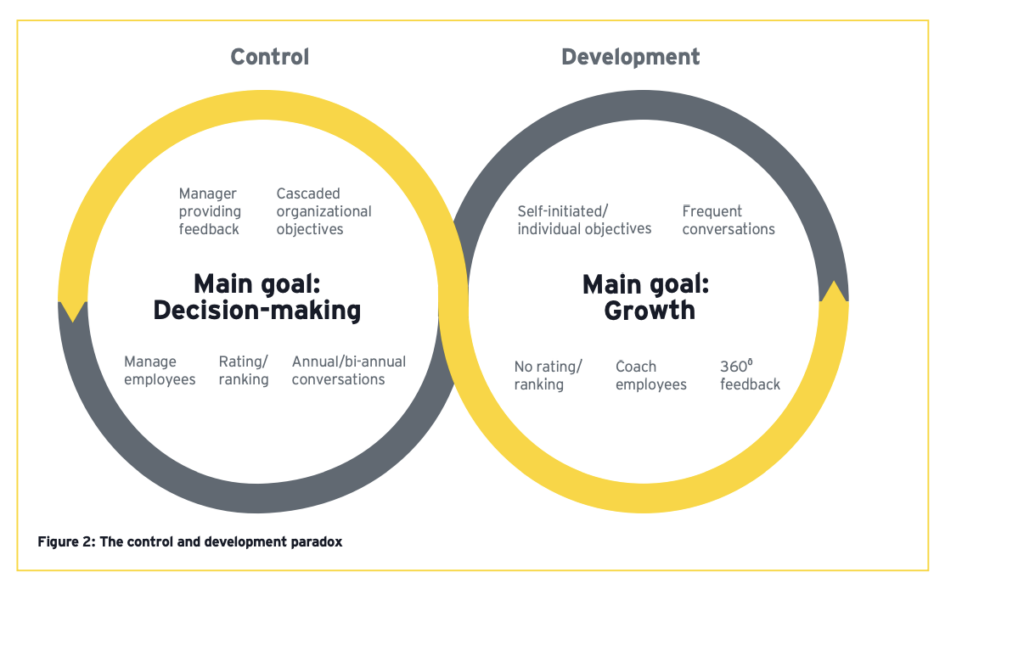Performance management is one of the most crucial business processes: companies that focus on their people’s performance are 4.2 times more likely to outperform their peers.
However, the way organizations approach performance management is undergoing a major shift. Gone are the days of annual reviews and rigid evaluation methods.
Today, businesses are focusing on continuous feedback, better goal setting, and data-driven insights to create more agile and effective performance management systems.
Here are some statistics and performance management trends to help you better understand this shifting landscape and its impact on HR professionals and businesses.
The Effectiveness Of Traditional Performance Management
Traditional performance management systems are increasingly seen as ineffective and outdated. The statistics paint a concerning picture:
- Only 14% of employees feel inspired to improve after performance reviews.
- 65% of employees believe evaluations are irrelevant to their jobs.
- 95% of managers dislike performance reviews, questioning their impact.
- Just 6% of CEOs find appraisal systems useful.
- For employees receiving ongoing feedback, 77% feel motivated compared to traditional reviews.
- Three-quarters (76%) of organizations rate their employees once per year but 45% of HR leaders do not think annual reviews are an accurate appraisal of employees' work.
- CEB research reveals that only 5% of managers have the skills to manage talent effectively without ratings, leading to a 14% decline in conversation quality.
- Employees report that their performance evaluations are most often based on their manager’s observations.
This tells us that infrequent, rigid evaluations are failing to address employee needs. According to EY research, they prioritize control over development, leaving employees feeling judged rather than supported.
This mismatch reduces engagement, motivation, and overall effectiveness. For managers, the lack of skills and proper frameworks increases these issues, turning reviews into a box-ticking exercise.
The control-development paradox perfectly summarizes it:

However, as I’ll go into it, organizations that focus on continuous, developmental feedback see measurable improvements.
Employees feel more aligned, motivated, and better equipped to grow, showcasing the urgent need for a shift from traditional methods to more agile performance strategies.
Continuous Performance Management
Continuous performance management (CPM) is changing the way companies approach employee performance.
Instead of relying on annual reviews, CPM encourages frequent feedback, goal updates, and real-time recognition. This shift isn’t just about keeping up with trends, it’s delivering real results.
Here’s what the data shows:
- Companies with continuous performance systems are 50% more likely to exceed their goals.
- They are 42% better at holding employees accountable, 39% better at attracting top talent, and 44% better at retaining it.
- Managers in these organizations rate their HR teams 50% higher, calling them “excellent” or “good.”
- Employees who get daily feedback are 3.6 times more motivated than those who only receive annual reviews.
- In remote setups, 63% of employees who receive feedback multiple times a week report being engaged at work.
CPM isn’t just about feedback; it also focuses on aligning goals, coaching employees regularly, and recognizing contributions as they happen.
In fact, development-based conversations increase the effectiveness of performance management by 49%, according to EY and DDI’s Global Leadership Forecast.
This approach is a significant improvement over traditional systems, ensuring employees stay engaged and motivated while helping organizations achieve better results.
For businesses looking to improve accountability, retention, and overall performance, CPM is proving to be a smarter and more effective strategy.
Goal Setting
Goal setting is at the core of effective performance management, yet many organizations miss the mark.
According to an HBR study, only 20% of companies successfully complete around 80% of their strategic goals, showing that organizations still have a long way to go in terms of effective goal setting.
Involving employees, using dynamic methodologies, and striking the right balance between achievable and aspirational goals are all key to unlocking better outcomes.
For example, only 30% of employees say their managers involve them in goal setting, but those who are involved are nearly 4 times more likely to be engaged.
When employees take part in setting their own objectives, they feel a stronger connection to their work.
This is crucial, as 93% of workers claim unclear company goals make it harder to align their personal goals with them and achieve meaningful results.
While it’s important for goals to be attainable, 31% of employees feel their managers fail to set goals that challenge them. Employees want goals that push them out of their comfort zones, which can lead to personal and organizational growth.
Adopting a goal-setting framework such as OKRs (objectives and key results) is one way of approaching this. Google says the ideal range for an OKR grade (essentially how much of the goal is achieved) is ~70%.
Consistently achieving objectives at full capacity suggests that your OKR goals lack ambition and require a bigger vision.
By involving employees, and ensuring clear and aspirational targets using frameworks like OKRS, companies can create a performance management system that drives engagement and aligns individual efforts with organizational success.
Employee Recognition
Employee recognition is directly tied to better performance. A culture that values and acknowledges contributions can lead to higher engagement, improved productivity, and stronger retention—all critical components of effective performance management.
According to the data:
- 69% of employees say they’d work harder if their efforts were better appreciated.
- Organizations with effective recognition programs are 31% less likely to experience voluntary turnover.
- 40% of employees rank managers as the group that has the most impact on them recognition-wise.
Top tip: Recognition programs are much easier to manage using employee recognition software.
360-Degree Feedback
Studies have shown that 360-degree feedback can enhance self-awareness and leadership effectiveness. For instance, research indicates that organizations implementing multi-rater feedback systems experience a 10% improvement in overall performance.
Additionally, over 85% of Fortune 500 companies utilize 360-degree feedback as a cornerstone of their leadership development processes, underscoring its perceived value as a performance management technique for enhancing leadership capabilities.
However, a study examining physicians in the United Kingdom found the effectiveness of 360-degree feedback is influenced by several factors, including the credibility of raters, the inclusion of narrative comments, and the facilitation of feedback.
Potential downsides, such as feedback quality issues and rater bias, must be managed to ensure the process leads to meaningful improvements in performance and leadership development.
For guidance here, check out Liz Lockhart Lance’s excellent guide to 360-degree feedback.
Performance Management Tools
Performance management tools are making it easier for organizations to track, evaluate, and improve employee performance.
These tools automate tasks like setting goals, giving feedback, and conducting reviews, replacing outdated methods such as spreadsheets (still used by 58% of companies).
By simplifying processes and centralizing data, they save time and ensure accuracy.
In fact, Betterworks’ 2024 State of Performance Enablement report found that effective performance management software improves employee engagement (by 11%), belonging (by 62%), and employee development (by 96%).
There are different types of performance management tools tailored to specific needs:
- Goal-setting tools like OKR software help employees and managers align their objectives with company priorities while tracking progress in real time.
- Feedback platforms such as Lattice or 15Five enable regular check-ins and open communication, improving engagement.
- Review systems like BambooHR or Workday automate evaluations, reducing the one to two weeks U.S. managers typically spend on a single performance review.
- Analytics-driven tools leverage data to identify trends and predict outcomes, helping managers make informed decisions.
When implemented effectively, these evaluation systems create a seamless process that benefits both employees and the organization as a whole.
10 Best Performance Management Software Shortlist
Here's my pick of the 10 best software from the 10 tools reviewed.
Key Takeaways
The findings make it evident that performance management must evolve to meet the demands of modern workplaces.
Continuous feedback systems help keep everyone aligned, motivated and on track.
Collaborative goal-setting, where employees have a voice, leads to stronger commitment and improved outcomes. Recognition, properly integrated into performance processes, can increase motivation and retention.
The adoption of modern tools further simplifies these processes, allowing organizations to save time while driving data-informed decisions.
The shift towards agile, transparent, and growth-focused systems is not merely beneficial–it is essential for long-term success.
Join For More HR Insights
In summary, as organizations redefine performance management, the emphasis must remain on practices that prioritize engagement, alignment, and growth.
By adopting more dynamic and inclusive strategies, businesses can not only improve their profitability but also create better personal outcomes for their workforce.
To remain up to date on all the latest in people management, subscribe to our weekly newsletter for HR and business leaders. You'll receive all our latest insights and offerings to help you grow in your career and make greater impact in your org.




